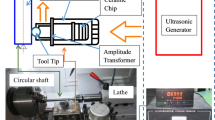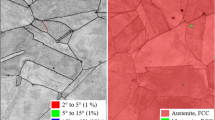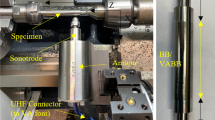Abstract
Ultrasonic-assisted ball burnishing (UABB) is a promising surface strengthening technology for improving the properties of components. This method superimposes ultrasonic vibration to the traditional deep rolling; it can improve the surface roughness of a material, enhance its surface hardness, and introduce a high compressive residual stress, thereby improving the fatigue performance of components. A mathematical model should be established to predict and analyze the relationship between the experimental process parameters and results and to predict the effect of UABB on surface roughness. In the present work, a mathematical model of surface roughness after UABB was established on the basis of Hertz contact theory, comprehensively considering the process parameters, dynamic vibration forces, and elastic rebound of the targets. UABB experiments were carried out to verify the correctness of the mathematical model. Results showed that UABB can significantly reduce the surface roughness of the material, and the values calculated from the derived mathematical model showed good agreement with the experimental findings. The surface roughness decreased with the burnishing force (50–250 N) and amplitude (4–10 μm) increased, whereas the feed rate decreased. The increases of radii of component and ball were detrimental to the improvement of the surface roughness. And elastic rebound was not conducive to roughness reduction and its influence was negligible. Finally, the derived surface roughness model can be used to predict the component values after UABB and understand the effects of machining parameters on the shaft targets during processing.

























Similar content being viewed by others
References
Bozdana AT, Gindy NNZ, Li H (2005) Deep cold rolling with ultrasonic vibrations—a new mechanical surface enhancement technique. J Machine Tools Manuf 45:713–718. https://doi.org/10.1016/j.ijmachtools.2004.09.017
Zhao XH, Xue GL, Liu Y (2017) Gradient crystalline structure induced by ultrasonic impacting and rolling and its effect on fatigue behavior of TC11 titanium alloy. J Results Phys 7:1845–1851. https://doi.org/10.1016/j.rinp.2017.05.026
Zhao WD, Liu DX, Zhang XH, Zhou Y, Zhang RX, Zhang H, Ye C (2019) Improving the fretting and corrosion fatigue performance of 300M ultra-high strength steel using the ultrasonic surface rolling process. Int J Fatigue 121:30–38. https://doi.org/10.1016/j.ijfatigue.2018.11.017
Zhang M, Zhang YX, Zhou Y (2019) Theoretical and experimental analysis of compressive residual stress field on 6061 aluminum alloy after ultrasonic surface rolling process. J Mech Eng Sci 233:5363–5376. https://doi.org/10.1177/0954406219850218
Guo W, Sun RJ, Song BW, Zhu Y, Li F, Che ZG, Li B, Guo C, Liu L, Peng P (2018) Laser shock peening of laser additive manufactured Ti6Al4V titanium alloy. Surf Coat Technol 349:503–510. https://doi.org/10.1016/j.surfcoat.2018.06.020
Sun RJ, Li LH, Zhu Y, Guo W, Peng P, Cong BQ, Sun JF, Che ZG, Li B, Guo C, Liu L (2018) Microstructure, residual stress and tensile properties control of wirearc additive manufactured 2319 aluminum alloy with laser shock peening. J Alloy Comp 747:255–265. https://doi.org/10.1016/j.jallcom.2018.02.353
Liu ZH, Yang MJ, Deng J, Zhang M, Dai QL (2020) A predictive approach to investigating effects of ultrasonic-assisted burnishing process on surface performances of shaft targets. Int J Adv Manuf Technol 106:4203–4219. https://doi.org/10.1007/s00170-019-04902-9
Revankar GD, Shetty R, Rao SS, Gaitonde VN (2014) Analysis of surface roughness and hardness in ball burnishing of titanium alloy. J Meas 58:256–268. https://doi.org/10.1016/j.measurement.2014.08.043
Zhang QJ, Cao JG, Wang HY (2016) Ultrasonic surface strengthening of train axle material 30CrMoA. C Procedia CIRP 42:853–857. https://doi.org/10.1016/j.procir.2016.03.007
Jerez-Mesa R, Travieso-Rodriguez JA, Gomez-Gras G, Lluma-Fuentes J (2018) Development, characterization and test of an ultrasonic vibration-assisted ball burnishing tool. J Mater Process Tech 257:203–212. https://doi.org/10.1016/j.jmatprotec.2018.02.036
John MRS, Wilson AW, Bhardwaj AP, Abraham A, Vinayagam BK (2016) An investigation of ball burnishing process on CNC lathe using finite element analysis. Simul Model Pract Theory 62:88–101. https://doi.org/10.1016/j.simpat.2016.01.004
Teimouri R, Amini S, Bami AB (2018) Evaluation of optimized surface properties and residual stress in ultrasonic assisted ball burnishing of AA6061-T6. J Meas 116:129–139. https://doi.org/10.1016/j.measurement.2017.11.001
Bouzid W, Tsoumarev O, Saï K (2004) An investigation of surface roughness of burnished AISI 1042 steel. Int J Adv Manuf Technol 24:120–125. https://doi.org/10.1007/s00170-003-1761-4
Hiegemann L, Weddeling C, Tekkaya AE (2016) Analytical contact pressure model for predicting roughness of ball burnished surfaces. J Mater Process Technol 232:63–77. https://doi.org/10.1016/j.jmatprotec.2016.01.024
Magalhães FC, Abrão AM, Denkena B, Breidenstein B, Mörke T (2017) Analytical modeling of surface roughness, hardness and residual stress induced by deep rolling. C JMEPEG 26:876–884. https://doi.org/10.1007/s11665-016-2486-5
Korzynski M (2007) Modeling and experimental validation of the force–surface roughness relation for smoothing burnishing with a spherical tool. J Machine Tools Manuf 47:1956–1964. https://doi.org/10.1016/j.ijmachtools.2007.03.002
Saï WB, Saï K (2005) Finite element modeling of burnishing of AISI 1042 steel. Int J Adv Manuf Technol 25:460–465. https://doi.org/10.1007/s00170-003-1993-3
Huang Y (1986) Local stress and its application. China Machine Press, Beijing
Teimouri R, Amini S (2019) Analytical modeling of ultrasonic burnishing process: evaluation of active forces. J Meas 131:654–663. https://doi.org/10.1016/j.measurement.2018.09.023
Teimouri R, Amini S (2018) Analytical modeling of ultrasonic surface burnishing process: evaluation of through depth localized strain. Int J Mech Sci 151:118–132. https://doi.org/10.1016/j.ijmecsci.2018.11.008
Zhang M, Liu ZH, Deng J, Yang MJ, Dai QL, Zhang TZ (2019) Optimum design of compressive residual stress field caused by ultrasonic surface rolling with a mathematical model. J Appl Math Model 76:800–831. https://doi.org/10.1016/j.apm.2019.07.009
Wang CL (2005) Plastic mechanics. China Architecture & Building Press, Beijing
Li FL, Xia W, Zhou ZY (2008) Analytical investigation and experimental verification of surface smoothing mechanism of roller burnishing. J S China Univ Technol 36:98–103
Johnson KL (1985) Contact mechanics. Cambridge University Press, New York
Funding
The authors received financial supports from the China National Natural Science Fund (No. 11602227) and China Scholarship Council (CSC201908410361).
Author information
Authors and Affiliations
Corresponding authors
Additional information
Publisher’s note
Springer Nature remains neutral with regard to jurisdictional claims in published maps and institutional affiliations.
Rights and permissions
About this article
Cite this article
Liu, Z., Dai, Q., Deng, J. et al. Analytical modeling and experimental verification of surface roughness in the ultrasonic-assisted ball burnishing of shaft targets. Int J Adv Manuf Technol 107, 3593–3613 (2020). https://doi.org/10.1007/s00170-020-05261-6
Received:
Accepted:
Published:
Issue Date:
DOI: https://doi.org/10.1007/s00170-020-05261-6




